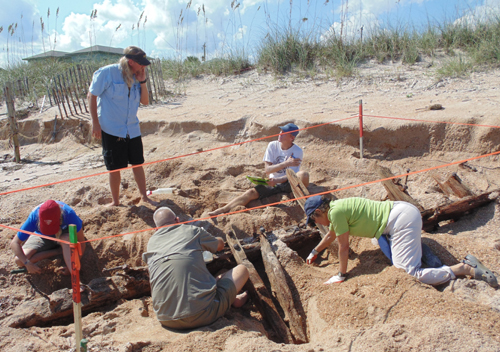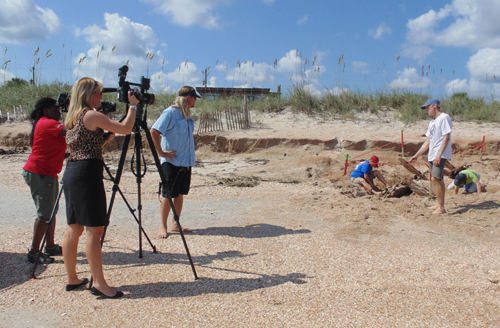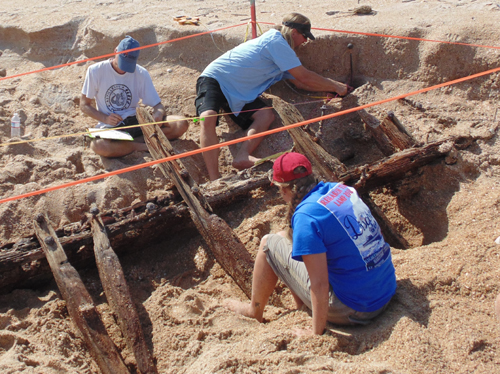
LAMP archaeologists investigate a newly discovered shipwreck site on Ponte Vedra Beach. From left to right are LAMP Archaeological Conservator Starr Cox, LAMP Director Chuck Meide, Lighthouse staff Dennis Kirk, LAMP archaeologist Sam Turner, and volunteer Peggy Friedman, who discovered the shipwreck two days earlier.
Last Wednesday morning our friend Peggy Friedman, who volunteers with the local sea turtle patrol, was walking the beach looking for sea turtle nests when she encountered something unexpected–the old wooden bones of a shipwreck jutting out from the dunes. Earlier in the week a nor’easter storm had raked our coast, and caused massive erosion of the beach, so that the the seaward half of the sand dune had effectively been scooped away, exposing the remains of the shipwreck. Peggy told the scientists at the GTM-NERR (Guana-Tolomato-Matanzas National Estuarine Research Reserve), who have jurisdiction over this location, and they contacted me here at LAMP.
A quick visit to the site with the other LAMP archaeologists confirmed that this was indeed the remains of a beached ship. After this brief inspection on Thursday, we knew that we had to return the following day for a more thorough investigation of the wreckage, and our public relations coordinator, Shannon O’Neil, sent out a notification to the press. Boy was there interest! During our investigation on Friday I was interviewed no less than six times! We lot a lot of great press, and the links to videos and newspaper articles are included below the fold . . .
Channel 4 News in Jacksonville (WJXT) broadcast this video, and you can read their story online here.
Jacksonville’s First Coast News also has video and a story:
“I saw a part of the ribs of the boat sticking out of the sand,” said Friedmann.
Her discovery lead to a team of archeologists from the St. Augustine Lighthouse Archaeological Maritime Program working to help unveil the story of the old wooden vessel.
“What we’re really looking at is the way the timbers were put together,” said Chuck Meide, Director of Archaeology. “The size of the timbers will give us some indication of the size of the vessel. The style of construction.”
The remains could be a shrimp boat, possibly from the early 1900s. Meide believes recent storms in the area helped Freidmann to make this discovery.
“A Nor’easter comes through rakes the coast you can see how the sand dune behind me is just like it’s been scooped away,” said Meide. “Unveiling this historic treasure that has been hidden for centuries. Exposed for the first time in years.”

Local and regional media interviewed the archaeologists throughout the day. There was a lot of interest in this shipwreck!
Jacksonville’s public television station, WJCT, has a story with a slideshow, along with an earlier story here:
Researchers say the shipwreck discovered on Ponte Vedra Beach this week has found it’s final resting place.
Chuck Meide, director of archeology at the St. Augustine’s Lighthouse Archeological Maritime Program told reporters at the wreck site this afternoon that after researchers take a close look at the remains and measure them they will rebury the ship . . .
Meide said returning the wreck to the earth is the safest place it could be.
About 15 feet of the ship’s ribs and keel were uncovered during the nor’easter that blew through the region this week. Researchers have been on the scene since Thursday.
Jacksonville’s Fox/CBS affiliate, Channel 30/Channel 47 ActionJax News did a live interview and a broadcast news story, and though I couldn’t find the story on their webpage, their video was reproduced on the Orlando Sentinel‘s page. This story was also picked up by Fort Lauderdale’s newspaper the Sun-Sentinel. Its great to see interest in our heritage across the entire state!
Our local National Public Radio station also broadcast a story on the investigation, though we don’t know if it is available online or not.
The story was also picked up by the Huffington Post website.

Archaeologists recording the exposed timbers. The size and arrangement of the ribs or frames suggest that this is the wreck of a shrimp boat cast ashore perhaps in the 1940s – 1960s.
Finally, our local paper, the St. Augustine Record had a great front-page story in Saturday’s edition:
Chuck Meide looked up from a sketch board, mentally measuring the ribs attached to the skeleton buried in the sand eight miles north of the St. Augustine Inlet.
Meide is the director of the Lighthouse Archaeological Maritime Program (LAMP). It’s tasked with hunting down, diving on or, in this case, digging up pieces of St. Augustine’s 500-year-old seafaring heritage.
LAMP staff and volunteers knelt or squatted in the red coquina shell that’s hidden the bones of this ship for decades.
Meide thinks it’s a shrimp boat, but nodded to a man walking up the beach toward the wreck and said, “But he’s our shrimp boat guy.”
Brendan Burke dug a toe in the sand and looked over the 20-plus feet of darkened timber and twisted iron spikes. He’s an archaeologist with LAMP and published a new book this week titled “Shrimp Boat City,” along with co-author Ed Long. It chronicles the history of shrimping in St. Augustine over a period of 100 years.
“Yeah,” he said. “It looks like a shrimp boat.” Best guess? It’s from the 1940s and would likely have been between 40 and 75 feet in length, judging primarily by the depth of the keel — one foot.
So the find isn’t ancient. It’s not Spanish, so forget about gold. It’s not English. But a good guess is that it is Minorcan-bred and built in St. Augustine sometime last century in one of the several shrimp boat yards that bent wood to its will and pinned it together with iron.
In a review of Burke’s book published last week in The Record he said, “St. Augustine really paved the way for today’s shrimping industry.”
“The shrimping industry up until the 1950s and the boatbuilding business up until the 1980s entirely sustained about one-eighth, if not more, of St. Augustine’s economy.”
So what’s the significance of the broken bones of a working boat disinterred by storms?
Meide said every sunken boat carries a cargo of questions. Any shipwreck here,” nodding toward the Atlantic waters, “is going to have some secret, some story to tell us.”

